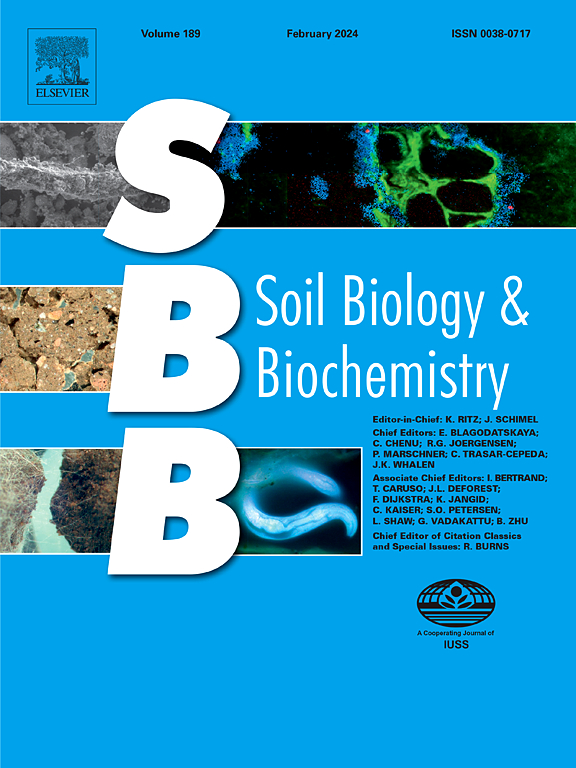土壤生物学与生物化学专刊“土壤有机质与土壤健康和脱碳的联系”手稿。生物固体改良的农业土壤中微生物胞内碳储存及其碳固存
IF 9.8
1区 农林科学
Q1 SOIL SCIENCE
引用次数: 0
摘要
为了进一步了解生物固体如何驱动土壤微生物为农业土壤固碳做出贡献,我们使用中性脂质脂肪酸(NLFA)量化了微生物细胞内的碳储存量,使用磷脂脂肪酸(PLFA)量化了微生物结构生物量,并通过分析土壤有机碳(SOC)的变化量化了土壤固碳量。伊利诺伊州西部富尔顿县的六块农田(1972-1984 年)经过累计 550 兆克/公顷-1 的生物固体处理,五块对照田施用农艺比率的化肥,还有一块参考田(该地区 SOC 含量最高)。与传统肥料土壤相比,生物固体改良土壤中每单位 PLFA 的 NLFA(NLFA/PLFA 比率)更高,尤其是细菌,这表明生物固体改良土壤中微生物细胞内以 NLFA 形式储存的 C 更高。尤其是放线菌标记的 NLFA/PLFA 比率比传统肥料土壤高出近四倍,G+ 细菌高出三倍,G- 细菌高出两倍。与传统肥料土壤相比,生物固体改良土壤中的细菌显然得到了更好的支持,具有更高的活性 SOC 和持水能力。最后一次施用生物固体 40 年后,生物固体改良土壤中新的 SOC 平衡为 3.18 ± 0.08%,传统肥料土壤中为 1.26 ± 0.02%,参考土壤中为 2.24 ± 0.07%。施用生物固体后,土壤的平均净固碳量为 37.1 ± 4.2 兆克/公顷-1,而施用常规肥料的土壤为 3.9 ± 0.2 兆克/公顷-1。据估计,施用生物固体可减少的温室气体排放量平均为 0.59 兆克二氧化碳当量兆克生物固体-1。与生物固体添加物相关的微生物通过其卓越的 NLFA 细胞内储存潜力,有可能提高农业土壤固碳的 SOC 水平。本文章由计算机程序翻译,如有差异,请以英文原文为准。


Intracellular carbon storage of microorganisms and resulting C sequestration in biosolids-amended agricultural soil
To advance our understanding of how biosolids drive soil microorganisms to contribute to carbon sequestration in agricultural soil, we quantified microbial intracellular C storage using neutral lipid fatty acids (NLFA), microbial structural biomass using phospholipid fatty acids (PLFA), and soil C sequestration by analyzing soil organic C (SOC) changes. Soil samples were collected in 2024 and several other years since 2008 in Fulton County, western Illinois, in six agricultural fields treated with biosolids (1972–1984) at 550 Mg ha−1 cumulatively, five control fields received agronomic rates of chemical fertilizer, and one reference field (the highest SOC in the region). Biosolids-amended soil showed a higher NLFA per unit of PLFA (NLFA/PLFA ratio) than conventional fertilizer soil, especially for bacteria, indicating higher microbial intracellular C storage as NLFA in biosolids-amended soil. In particular, the NLFA/PLFA ratio was almost fourfold higher for Actinomycetes markers, threefold higher for Gram+ bacteria, and twofold higher for Gram- bacteria in biosolids-amended soil than in conventional fertilizer soil. Bacteria in biosolids-amended soil were evidently better supported with higher active SOC and water-holding capacity than in conventional fertilizer soil. The new SOC equilibrium 40 years after the last biosolids application was 3.18 ± 0.08 % in biosolids-amended soil, 1.26 ± 0.02 % in conventional fertilizer soil, and 2.24 ± 0.07 % in reference soil. Resulting mean net soil C sequestration in response to biosolids application was 37.1 ± 4.2 Mg ha−1 compared to 3.9 ± 0.2 Mg ha−1 in conventional fertilizer soil. Greenhouse gas emission reduction by biosolids application was estimated to be on average 0.59 Mg CO2-equivalent Mg biosolids−1. Microbes associated with biosolids addition have the potential to improve SOC levels for agricultural soil C sequestration via their superior NLFA intracellular storage potential.
求助全文
通过发布文献求助,成功后即可免费获取论文全文。
去求助
来源期刊

Soil Biology & Biochemistry
农林科学-土壤科学
CiteScore
16.90
自引率
9.30%
发文量
312
审稿时长
49 days
期刊介绍:
Soil Biology & Biochemistry publishes original research articles of international significance focusing on biological processes in soil and their applications to soil and environmental quality. Major topics include the ecology and biochemical processes of soil organisms, their effects on the environment, and interactions with plants. The journal also welcomes state-of-the-art reviews and discussions on contemporary research in soil biology and biochemistry.
 求助内容:
求助内容: 应助结果提醒方式:
应助结果提醒方式:


